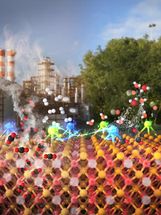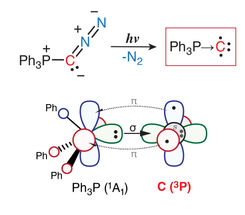Injecting carbon dioxide to extract methane from methane hydrate deposits?
Two of the most pressing problems of our time are the ever-dwindling fossil fuels and the threatening climate change resulting from the increasing release of carbon dioxide. A means to simultaneously remove carbon dioxide while also producing methane would truly resemble the Philosopher's Stone. Is this a utopian vision or reality? A team of Canadians and Koreans, headed by John A. Ripmeester, has now verified the practicability of such potential future technologies.
What it's all about? Some time ago, huge deposits of "combustible ice" were found at the edges of the continental plates and in regions of perpetual ice. The substance in question is methane hydrate, which was formed from methane and water by the decomposition of microorganisms at low temperatures and high pressure. It is attractive to think we could release the methane in these reservoirs in order to exploit the relatively clean-burning gas as a future energy source. However, extracting the methane isn't exactly trivial, since it isn't stored in a "gas bubble", but rather as a solid, locked into an ice-like structure. It has been theorized that we could force the methane out of its icy prison-by forcing in carbon dioxide, which could thus be elegantly stored away for the long term. But can this theory be put into practice?
Two things have to be right in order for a reaction to work: The thermodynamics determine the equilibrium that is established between reactants and products and thus give us information about the maximum possible yield. The kinetics determine how long it will take to reach this equilibrium. Calculations led Ripmeester and his colleagues to the realization that both of these parameters are favorable for this particular venture. Laboratory experiments then also demonstrated that carbon dioxide could extract gaseous methane from methane hydrate. However, the quantity of methane obtained was significantly lower than the kinetic and thermodynamic considerations indicated. One reason for this could be the initial exchange of the gases on the surface of the hydrate particles. Inside the crystals, islands of methane hydrate remain, surrounded by a mixed hydrate. Further exchange is then no longer possible. It is no wonder that factors such as the distribution of methane hydrate in the sediment and especially the size of the crystals within a specific deposit have a large influence on the yield, deciding the success or failure of the technology.
Most read news
Other news from the department science

Get the chemical industry in your inbox
By submitting this form you agree that LUMITOS AG will send you the newsletter(s) selected above by email. Your data will not be passed on to third parties. Your data will be stored and processed in accordance with our data protection regulations. LUMITOS may contact you by email for the purpose of advertising or market and opinion surveys. You can revoke your consent at any time without giving reasons to LUMITOS AG, Ernst-Augustin-Str. 2, 12489 Berlin, Germany or by e-mail at revoke@lumitos.com with effect for the future. In addition, each email contains a link to unsubscribe from the corresponding newsletter.



















































